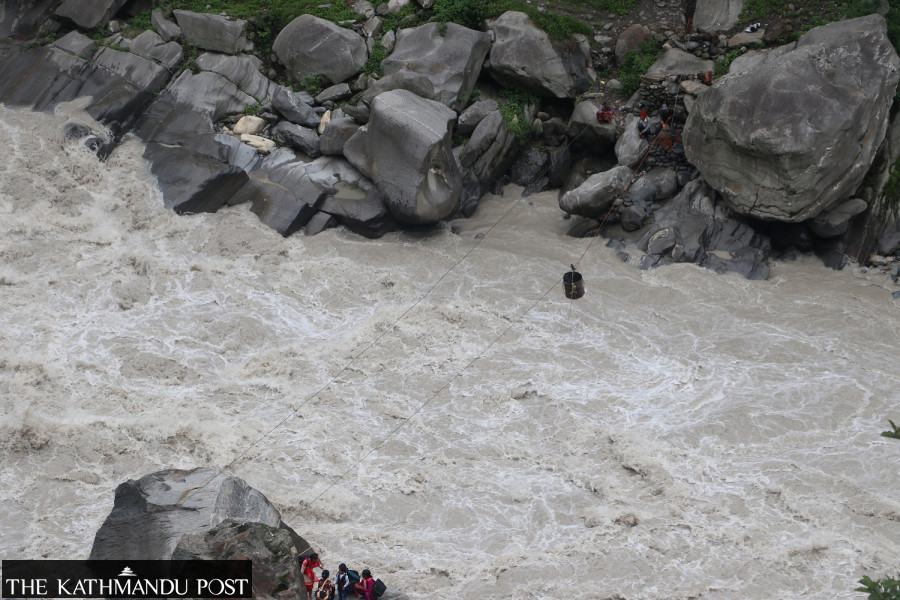National
Bureaucratic inertia delays report on Darchula missing youth probe
Almost a month since Dhami fell into Mahakali trying to cross the river on a cable, the government is yet to share what exactly happened and its position on the incident.
Anil Giri
On Monday, the Ministry of Home Affairs held an interaction with former home secretaries, and former and present heads of security agencies like the Nepal Police, the Armed Police Force and the National Intelligence Department.
During the interaction, Nepal Police presented a briefing, which attendees said was comprehensive, about its operation and functions. The Armed Police Force that is mandated to look after border areas, apart from guarding some vital installations and responding to disasters, barely had any role throughout the programme.
A former home secretary present at the interaction said several participants were surprised that the country's primary security agency that guards the national territory was ignored.
“It looks like the Home Ministry is filled with the officials who have no idea about the agency’s nature, its norms and values, and its primary objectives,” said Govinda Kusum, a former home secretary, who also attended the interaction.
Kusum’s assessment, by extension, is also a reflection of how some pressing issues are not duly being taken care of by the ministry.
“Take for example the Darchula incident,” Kusum told the Post. “Where is the report of the committee formed to investigate the incident in which a youth had fallen into Mahakali from the tuin he was using to cross the river?”
It has been more than three weeks since Jaya Singh Dhami, 33, of Darchula fell into the Mahakali. The swollen river immediately swept him away. Locals are still searching for him.
Initial reports, based on eyewitnesses’ accounts, suggested that the improvised cable crossing was dismantled by a member of India’s Sashastra Seema Bal. There was quite an uproar in Kathmandu after the Darchula incident. The issue was raised in Parliament where not only the main opposition, CPN-UML, but also some members of the ruling alliance came down heavily on the Sher Bahadur Deuba government.
A day after the incident, the Home Ministry on August 1 formed a five-member team to probe into the matter. It was initially given 10 days to find the facts and submit the report. Janardan Gautam, a joint-secretary at the ministry, headed the investigation team. The team visited Darchula district and held interaction with eyewitnesses and local residents about the incident. But after failing to meet the deadline, it was given seven days more. After it failed to submit the report within the extended deadline, the ministry gave another seven days. The latest deadline expires on Wednesday.
Gautam said there were multiple factors that led to the delay in completing the report on time.
“Out of five, one member left for India for treatment. Another member left for Ilam after his father passed away,” Gautam told the Post on Monday. “As you know, this issue is quite sensitive. The area is also remote so it took time to complete the investigation. We have almost finalised the report.”
When asked to share his team’s findings, Gautam said they are yet to “write the conclusion”.
“As soon as the two members are back, we will discuss the findings and give our conclusion,” said Gautam. “Given the sensitivity of the issue, we have tried to examine every aspect meticulously. At this stage, I cannot share anything about our investigation with the media.”
Kathmandu’s nonchalant attitude when it comes to the plight of Nepalis from remote and far-flung areas like Darchula is not new though. Darchula is the district where the Kalapani area falls, which both Nepal and India claim to be their own. The KP Sharma Oli government in May last year unveiled a new map of Nepal showing Kalapani, Lipulekh and Limpiyadhura within the Nepali territory.
After the publication of the new map, Nepal and India were in a state of cartographic war.
With no road access to Darchula, locals from here are forced to use such cable crossings and rubber tubes to cross the mighty Mahakali river whenever they need to buy daily essentials, which are available only in the Indian market, or whenever they need to travel to Kathmandu.
Dhami too was crossing the river to reach Kathmandu when he fell into the river.
Kalapani has remained a major irritant in Nepal-India relations, but neither side has done enough to resolve the issue. After the erstwhile Oli government unveiled the new Nepali map, in response to India opening a route via Lipulekh, New Delhi had not hidden its displeasure.
With eyewitnesses implicating a member of the Indian security force of unfastening the cable crossing, leading to the fall of Dhami, the newly formed Deuba government was under pressure to address the issue promptly. When the incident happened, the Deuba government was just 18 days old.
The Indian side has claimed that none of its security personnel was involved in the incident. Nepal, however, has not been able to make any concrete position on the incident.
In an interview with ekantipur.com on Sunday, Nepal’s Ambassador to India Nilamber Acharya also made it clear that there has been no official government position on the incident yet.
“As far as the Darchula incident is concerned, first there has to be an official position of our government. Isn’t it asking a bit too much from an ambassador to lodge a protest with the Indian side based on some media reports?” said Acharya when asked if he had spoken with the Indian side regarding the incident.
Kusum, the former home secretary, says it looks like the government does not want to antagonise India.
“Otherwise, there is no reason to delay the publication of the report,” Kusum told the Post. “But again, I see a bigger problem. There is an institutional crisis. There are hardly any people in the Home Ministry who really understand what it is meant for.”
This is not the first time that the Home Ministry has made delays on issues and created confusion, ultimately failing to deliver.
“In the last 30 years, several private and public organisations and corporations have changed their working styles, introduced several reforms, but the Home Ministry seems to have been stuck in a time warp,” a former joint-secretary who served at the ministry for seven years told the Post.
“There are several incidents related to natural calamities, cross-border issues and security related matters where the ministry has utterly failed to complete its task by the deadline.”
According to the joint-secretary, there is no urgency among officials at the Home Ministry to address any issue.
“The delay in completing the investigation reflects the inertia and lethargy of the ministry,” the joint-secretary told the Post.
Successive governments in Kathmandu have, historically, taken a half-hearted approach when it comes to cross-border and territorial issues with India. Many say the rulers in Kathmandu often try to maintain a mild position when it comes to issues related with India. Though most of the territorial disputes have largely been sorted out, two areas still continue to be the source of friction between the two countries—Kalapani and Susta.
But Kathmandu failing to promptly take up the disappearance of the Darchula youth in an incident that can be easily termed criminal shows the state’s complete apathy for its citizens, some say.
“I see an utter lack of seriousness on our side while dealing with the recent Darchula incident or other similar issues,” said Chandi Shresth, also a former home secretary. “The incident could have been dealt with in a more effective manner without affecting the Nepal-India ties.”
According to Shrestha, there is no need to damage the two countries’ relations over a particular incident and practical solutions should be sought to avoid repeating such incidents in the future.
“If the Nepali side is holding back the report [of the Darchula incident] just to prevent any uproar or protests, it’s not a good policy,” Shrestha told the Post. “I see mistakes from both sides. If the Indian side had apologised, the situation would have been different.”
But for the truth to come out, the report must come out first.
A former chief of a security agency said Nepal home administration’s working style has been lethargic for decades.
“But in this particular Darchula incident, the delay in making the report public could be a deliberate move,” said Devi Ram Sharma, who headed the National National Intelligence Department from 2003 to 2007. “This incident is directly tied to two countries.”




 16.2°C Kathmandu
16.2°C Kathmandu







%20(1).jpg&w=300&height=200)






